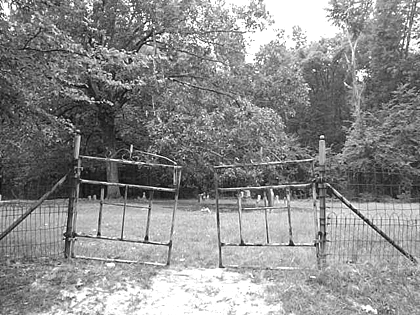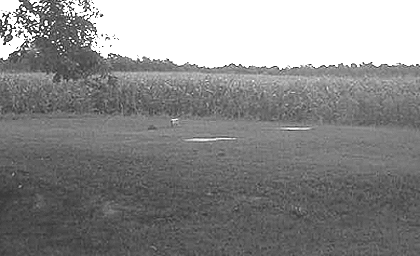The Bell Witch: The Full Account (41 page)

Bell was born in Edgecombe County, North Carolina,
where he spent his early childhood before moving to
Tennessee with his family. He joined the Tennessee
Militia in 1814 and fought in the Creek Indian War
and the battles of Horseshoe Bend and New Orleans
under the indirect command of Major General
Andrew Jackson. 66
He married Martha Gunn, daughter of the
Reverend Thomas Gunn, in September of 1817.
Jesse and Martha Bell’s family, which ultimately
consisted of nine children, lived in Robertson
66
Tennessee Military Service Records
, State Library and Archives, Nashville.
THE BELL WITCH: THE FULL ACCOUNT
305
County, Tennessee up until the 1837-1842 period
when they moved to Panola County, Mississippi. 67
They settled and developed farmland in the
present-day community
of Eureka, about seven miles
east of Batesville, Mississippi. Jesse and Martha
Bell’s first child, John Thomas Bell, was the
patriarch of the Mississippi Bell Witch legend
discussed in Appendix I. Their third child, Sarah
Elizabeth Bell, married her first cousin, Jesse Bell
Porter, a son of Alex and Esther Porter.
Jesse Bell died in 1843 while visiting friends in
Christian County, Kentucky near the present-day
town of Hopkinsville. His place of burial is unknown;
however, there exists a gravestone in a Hopkinsville,
Kentucky cemetery bearing the faint inscription of
the name “Bell,” and listing 1843 as the date of
death. 68
One of Jesse Bell’s direct descendants has pointed
out the possibility that he could have been buried in
the Bell family cemetery at Red River because of its
close proximity to Hopkinsville. Although no visible
markers exist suggesting this was the case, it is
nevertheless a very strong possibility.
Martha Gunn Bell died in 1881, and is buried
along with several of her children in Long Creek
Cemetery in Panola County, Mississippi. It remains
unknown to this day whether she was buried in the
black stockings as Kate requested.
67 Time frame arrived at by examining real estate, tax, and census records.
68 Riverside Cemetery, Hopkinsville, KY.

306 P A T
F I T Z H U G H
Located in Panola County, Mississippi, Long
Creek Cemetery is where a number of Jesse
Bell’s descendants are buried, including the
woman asked by “Kate” to be buried in black
stockings, Martha Gunn Bell. Long Creek
Cemetery is also where much of the Mississippi
version of the legend allegedly took place.
Esther Porter (1800-1859)
It was Esther Bell Porter who witnessed the
terrifying apparition of the “witch family” bouncing
on saplings in the field across from her home.
Born in Halifax County, North Carolina, Esther
Bell was the eldest of John and Lucy Bell’s two
daughters. After arriving in Tennessee with her
family in 1804, she spent her childhood at the Bell
farm on Red River. Esther was the first of John
Bell’s children to wed, marrying Alexander Bennett
(Alex) Porter in July of 1817.
During the 1836-1840 period, the Porters moved
to Panola County, Mississippi, settling near the
THE BELL WITCH: THE FULL ACCOUNT
307
present-day town of Oakland. 69 They had 12
children, several of whom died at birth or at very
young ages. Esther Bell Porter died in 1859, and is
allegedly buried in Union Hill Cemetery near
Oakland, Mississippi. ii
John Bell, Jr. (1793-1862)
John Bell, Jr. was Kate’s harshest critic by far.
While others around the community and in the Bell
household seemed terrified by Kate’s presence, John
Jr. was never at a loss for words. He yelled, cursed,
challenged her, and consistently maintained that he
knew what she was and was not afraid of her in any
way. Kate took notice of his boldness, often stating
that he was a very smart man and that she had
considerable respect for him.
It was with John Bell, Jr. whom Kate intelligently
debated and shared her predictions of major world
events during her 1828 return-visit to the Bell farm.
It is also believed that John Jr. was the first person
Kate visited upon her return-visit, and that it was he
and his best friend, Frank Miles, whom she bade her
last farewell.
In his later years, John Bell, Jr. spent two days
describing in meticulous detail his private
conversations with Kate as his son, Dr. Joel Thomas
Bell, listened and took notes. The younger Bell later
shared this information his son, Dr. Charles Bailey
Bell, who included much of it in his book, “The Bell
Witch – A Mysterious Spirit,” published in 1934. jj
Recent findings indicate that these conversations
might have been a hoax, the reasons for which will
be discussed in a future edition of the book you are
reading.
69 Time frame was arrived at by comparing tax and real estate records in both states.

308 P A T
F I T Z H U G H
John Bell, Jr. spent his early childhood in Halifax
County, North Carolina and moved to Tennessee with
his family in the winter of 1803-1804. He later
joined the Tennessee Militia and fought in the battles
of Horseshoe Bend and New Orleans along with his
brother, Jesse, under the indirect command of Major
General Andrew Jackson. 70
In 1815, John Jr. and his brother Drewry, along
with Alex Gunn, used flatboats to carry goods from
nearby Port Royal to the southern markets of
Natchez and New Orleans. They sold scrap wood
from their boats to finance their trip home along the
Natchez Trace.
In November of 1828, John Bell, Jr. married
Elizabeth Gunn and built a house just south of the
original Bell home. They raised six children and
amassed over 600 acres. He also served as a
magistrate for several years.
The flat gravestone in the foreground marks
the grave of John Bell, Jr.
He died from pneumonia on April 8, 1862, and is
buried along with his wife and several of their
70
Tennessee Military Service Records
, State Library and Archives, Nashville.
THE BELL WITCH: THE FULL ACCOUNT
309
children in a small cemetery near where their house
once stood. kk The house burned sometime after
Bell’s death, but its remnants are still evident today
in the form of charred bricks and stones.
Drewry Bell (1796-1865)
Drewry Bell was one of the first people to
experience an apparition of Kate, which came in the
form of a giant, mysterious bird sitting on the fence
by the lane leading from the main road to the Bell
home. As he began shooting at the creature, it
vanished and was never seen again. This apparition
occurred only a short time after his father, John Bell,
encountered the mysterious, “dog-rabbit” in a corn
row – which is widely believed to have been the first
known apparition of Kate.
It is said that Drewry Bell lived his entire life in
constant fear of Kate, and harbored very bitter
feelings toward her because of his younger sister’s
trials and tribulations. Although he seldom spoke of
Kate, he often referenced the physical and emotional
torment his sister experienced and the evil,
demented force responsible for it.
The third son of John and Lucy Bell, Drewry was
born in Halifax County, North Carolina and spent his
early childhood there before moving to Tennessee
with his family. A lifelong bachelor, Drewry Bell
made his home across the Red River from the Bell
farm in the years following Kate’s visit. He became a
successful farmer and amassed six slaves to help
him. It is not clear whether he owned the land he
lived on, as the 1830 Federal Census lists him as
owning no land, but six slaves.
Drewry Bell’s slaves built their own place of
worship near his home, and named it “Bell’s Chapel.”
310 P A T
F I T Z H U G H
After Bell’s death, the church was physically moved
across the Red River and put on land situated just
across Keysburg Road from the present-day driveway
of the Kirbys and Bell Witch Cave. A new building
has long since been erected, however the frame and
boarding of the original building still stands in a
thicket adjacent to the modern building.
Drewry Bell died on New Year’s Day of 1865, and
is presumably buried along with his parents and
several siblings in the old Bell cemetery near Adams,
Tennessee. In his will, he left Elizabeth twenty-five
dollars — five times the money he left each of his
other siblings. It is interesting to note that four of
the six siblings Drewry Bell left money to were
already deceased at the time his will was written and
dated, September 2, 1864. 71
Zadok Bell (1803-1826)
Zadok Bell had no known encounters with Kate.
Born in North Carolina just before his family’s
emigration to Tennessee, he would have been
fourteen years old at the time the disturbances
began. Given that he was being educated to become
a lawyer, it is possible that he spent some of his
adolescent years in a boarding school; however, the
author has no proof of this.
Zadok completed his advanced education and
became a bright lawyer, marrying Katherine
Lawrence in Rutherford County, Tennessee in July of
1821 and moving to the “Montgomery Settlement” in
southern Alabama soon thereafter. Aware that the
Apalachee Indians had relinquished most Florida
panhandle territories, he moved to Florida with
hopes of setting up a successful law practice. He
71
Robertson County TN Will Book 17
, pp. 644-645.
THE BELL WITCH: THE FULL ACCOUNT
311
settled in an area known as the Tallahassee
Settlement, which was established in April of 1824
when seven men camped near the present-day
capital. 72
After spending less than a year in the Tallahassee
Settlement, Zadok Bell moved back to Alabama
where he died of Yellow Fever in a sweeping epidemic
that struck the region in 1826. It is widely believed
that Zadok Bell is buried in the old Bell cemetery
near Adams, Tennessee; however, a small amount of
research performed by the author indicates that he is
actually buried near Montgomery, Alabama.
Richard Williams Bell (1811-1857)
Although only six years old when Kate’s
disturbances began, Richard Williams Bell vividly
remembered the many terrible encounters that he,
his parents, and siblings had with Kate. He is
credited with authoring the only known eyewitness
account of the disturbances.
In 1846, Bell journalized the disturbances in a
comprehensive manuscript that he later passed on to
his son, Allen Bell, who later circulated it among his
closest family members. In the late nineteenth
century, Martin Ingram incorporated Richard
Williams Bell’s manuscript into his book,
“Authenticated History of the Bell Witch,” where it
appears as a single chapter entitled, “Our Family
Trouble.” Both the inclusion of Bell’s manuscript